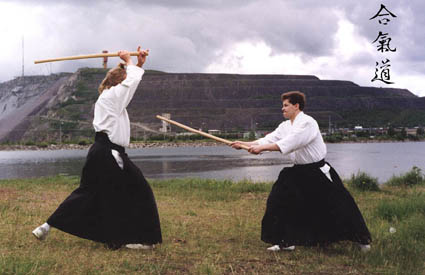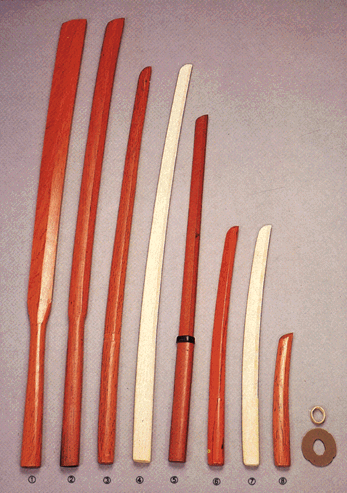|
|||
|
| -Countries |
| -Dictionary |
| -Federations |
| -M.A. Timeline |
| -Number System |
| -Styles |
| -Weapons |
| -Who's Who |
| -Updates |
| -Credits |
| -Stats |
| -Webmaster |
| Bokken History
The sword that seem to have been in general use during the Jokoto period (prior to 800 AD) are of the strait type, single or double edged and poorly tempered. There seems to be no standard design, they vary between two and four feet in length, and their common feature is the fact that they are all slung from the waist by cords, and used with a stabbing action. Historical evidence suggest that they were made by Chinese and Korean smiths working in Japan, as well as native artisans. It is generally agreed that the firs swords of the type that became the standard weapon of the Samurai, were made by the smith Amakuni at some time during the 8th century AD. The adoption of the efficient curved edge was a massive step forward in the weapon technology of the period, which coupled with the improvements in tempering techniques, culminated seven centuries later in the golden age of swordmaking between 1394 and 1427 when swords of a quality rarely equaled, and never surpassed, were made.
During the Sengoku Jidai, the absence of a strong central government and the subsequent power vacuum, encouraged the provincial warlords to fight among themselves in continuous and bloody attempts to enlarge their respective territories, and thus their wealth. The demand for weapons was insatiable, and to fill it smiths literally began mass-producing inferior weapons by using for the first time, steel purchased from a central source, and new, much faster forging methods that speeded up production at the expense of quality. Where previously a smith would make his own steel from iron sand or ore, then with great care forge and temper a fine blade, now ready made, sometimes imported steel would be overheated to facilitate quick forging. The resultant sword while beautiful in appearance, would lack the strength and sharpened of earlier weapons, an example of a pretty face hiding a worthless heart. The true beauty of a sword is in its sharpness, strength and the appearance, only when these three elements are combined into a weapon that will perform well in the hands of swordsman, can it be called beautiful. Swords that chip as soon as they contact a hard object, or that when used as intended and sharpened regularly, reveal, as the outer hardened steel is removed by the sword polisher, low grade soft core, are not true Nippon To (Japanese sword). They do not deserve therefore to share the fine reputation established by the blades of the master smiths, that were produced using the traditional methods. These days, only Toyama, Ioriken and Nakamura schools actually perform tameshigiri (test cutting), and so only they understand the true method of using a sword. When the smoke cleared over the battlefield of Sekigahara
at the conclusion of the bloody battle of 1600, the casualty count
revealed an overwhelming victory for General Tokugawa Ieyasu,
and the foundation was laid for a period of peace that would last
almost three hundred years. In the two and a half centuries that
followed, rarely was a sword drawn in anger and therefore th Since interest in the martial art of Japan first developed in the West, it has always been assumed that the true art of swordsmanship died out around the time of the Meiji Restoration, or perhaps shortly afterwards when the wearing of swords by the Samurai was forbidden. Indeed, some historians would suggest that following the battle of Sekigahara in 1600, practical swordsmanship went into a decline during the peaceful Tokugawa years, from which it never recovered. The conclusion being therefore, that the art of practical swordsmanship died long before the late 19th century. Fortunately for this and future generations, neither is true. In 1875, as the Meiji era began and Japan stood on the threshold of its modern industrial future, the Toyama Gakko was established under the new order and proved subsequently to be just the vehicle to preserve and carry the age old art of swordsmanship into the twentieth century. Founded to train military personal in swordsmanship, as well as other military disciplines, it used as its basis for "Gunto Soho" or military sword method, the most effective techniques of the then living master swordsmen, all of witch were performed from a standing position. This combination of techniques from various old schools, notably the Omori Ryu, and their adoption by the army, led later to the foundation of the Toyama School of swordsmanship in 1925. Other schools of swordsmanship still in existence at the time of the Meiji Restoration, did not fare so well however. As the age of democracy dawned, training halls that had originally only taught the old methods to Samurai, turned to the mass market now afforded them to survive in the absence of their former patrons. By 1870, several well known dojo in Tokyo area, the Chiba, Saito and Asari training halls were teaching an easier less vigorous form of swordplay to their customers. Thus Kenjutsu for the Samurai, evolved into Kendo for the commoner, and as a result much that was good became lost. In the Spartan confines of military academies, Kenjutsu
did however manage to survive. In the Rikugun Toyama Gakko both
the techniques and the spirit of the Samurai were kept alive in
the most practical way as in the 1943 publication; 2Japan Military
Masters -"The Army i For evidence of the practical effectiveness of the Toyama school sword techniques in particular, we have only to refer to an American publication entitled "The Jap Soldier", published in 1943 it would appear for the benefit of U.S. Army officers anticipating an encounter with their opposite numbers on the battlefield. It states; "Japanese officers still favour the old fashioned sword. You will see them leading their troops with swords waving, just as in old fashioned movie thrillers. Shoot these officers as quickly as you can, for those swords can slice a man from collar-bone to waist in a single clean slash". Until now, even in Japan, Toyama Ryu Batto Jutsu has remained little known outside of military circles. As a result it was able to avoid the pressure exerted by the occupying US forces at the end of the Second World War, in their effort to turn "unacceptable" martial arts into "acceptable" sports that the occidental mind could more easily understand. As such it has remained a practical and effective martial art. For those seeking the way of the Samurai, the path lies here. The techniques are combat effective, yet dignified; ruthlessly efficient yet graceful, we are indeed fortunate that they still exist. Unlike Kendo, the modern sportive form of Japanese fencing, or the companion art of sword drawing known as Iai-do, Batto Jutsu is the original art of unsheathing the incomparably sharp Japanese sabre, and in one continuously movement, cutting down an aggressor. The beauty of Toyama Ryu Batto Jutsu, lies in its Spartan simplicity and deadly effectiveness; devoid of artificial or theatrical postures, it is simply an efficient, practical and blindingly fast way of mortally wounding an opponent in a single decisive act of self defence. It's destructive power is devastating, as can be seen from the skilled swordsman's ability to cut cleanly through all manner of tough materials even iron and steel. This can only be learnt in a traditional school where the old methods, based on actual combat experience are still followed, and the true method of cutting therefore, fully understood. |

 However,
when massed infantry engagements replaced the mounted cavalry
skirmishes of previous ages, the heavy Tachi type sword worn edge
downwards as best suited the mounted warrior, who drew his sword
with a distinct upward movement to clear it from its scabbard
and avoid cutting his mount, was replaced by the shorter lighter
Katana, worn edge upwards, and thrust through the sash. This seemingly
insignificant modification in the manner in which the sword was
worn, was in fact the beginning of an entirely new method of combat
that would have a dramatic effect on the way future generation
of Samurai waged war. With the sword firmly secured in the waist
band edge up, the Samurai could draw and cut forwards in one rapid
movement, and thereby defend himself without the need to first
draw the sword and adopt an offensive posture. From this time
onwards, Kenjutsu (the use of already drawn sword) and Batto-jutsu
(drawing and simultaneously cutting with the sword) became separate
but parallel disciplines, and recognizable systems or schools
were established for both.
However,
when massed infantry engagements replaced the mounted cavalry
skirmishes of previous ages, the heavy Tachi type sword worn edge
downwards as best suited the mounted warrior, who drew his sword
with a distinct upward movement to clear it from its scabbard
and avoid cutting his mount, was replaced by the shorter lighter
Katana, worn edge upwards, and thrust through the sash. This seemingly
insignificant modification in the manner in which the sword was
worn, was in fact the beginning of an entirely new method of combat
that would have a dramatic effect on the way future generation
of Samurai waged war. With the sword firmly secured in the waist
band edge up, the Samurai could draw and cut forwards in one rapid
movement, and thereby defend himself without the need to first
draw the sword and adopt an offensive posture. From this time
onwards, Kenjutsu (the use of already drawn sword) and Batto-jutsu
(drawing and simultaneously cutting with the sword) became separate
but parallel disciplines, and recognizable systems or schools
were established for both. ere
was no method other than cutting the bodies of dead criminals,
by which to judge the cutting ability, as well as the strength
of a sword. The wearing of swords was prohibited by the edict
of 1876.
ere
was no method other than cutting the bodies of dead criminals,
by which to judge the cutting ability, as well as the strength
of a sword. The wearing of swords was prohibited by the edict
of 1876. n
Japanese Life". "From the point of view of the infantry,
the Toyama School of Physical training, must be mentioned. Younger
officers, particularly non-commissioned men and first and second
lieutenants are chosen by their regimental commanders to attend.
Instructions are given in different groups according to rank.
Bayonet fighting, Japanese fencing, Ju-jutsu and Japanese wrestling
are included in addition to the usual courses of physical training
schools".
n
Japanese Life". "From the point of view of the infantry,
the Toyama School of Physical training, must be mentioned. Younger
officers, particularly non-commissioned men and first and second
lieutenants are chosen by their regimental commanders to attend.
Instructions are given in different groups according to rank.
Bayonet fighting, Japanese fencing, Ju-jutsu and Japanese wrestling
are included in addition to the usual courses of physical training
schools".